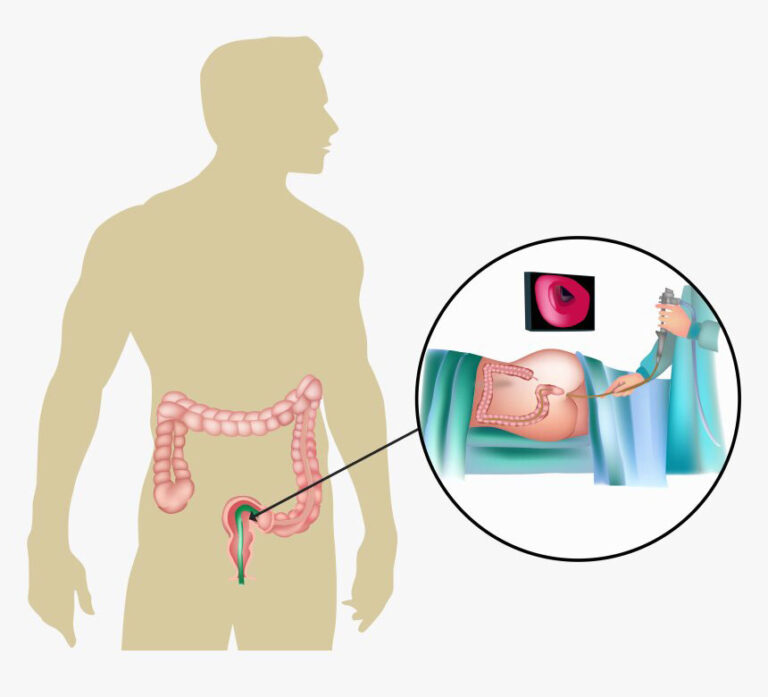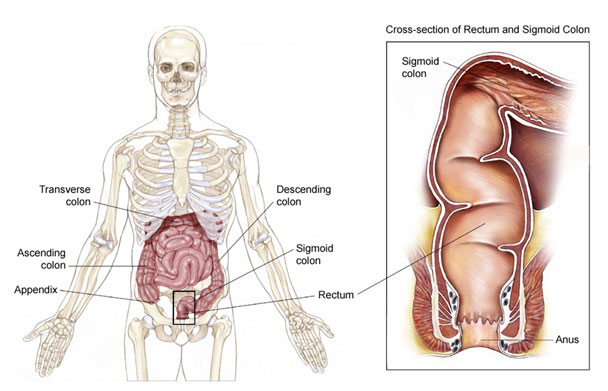FLEXIBLE SIGMOIDOSCOPY
A flexible sigmoidoscopy is an examination used to assess the lower part of the large intestine (colon). During a flexible sigmoidoscopy examination, a thin, flexible tube (sigmoidoscope) is inserted into the rectum.
A small video camera at the tip of the tube enables the doctor or primary care physician to view the inside of the rectum, the sigmoid colon, and most of the descending colon just under the last two feet (about fifty centimeters) of the large intestine. If required, tissue samples (biopsies) could be taken through the scope during a flexible sigmoidoscopy examination.
Flexible sigmoidoscopy does not allow the doctor or primary care physician to see the entire colon. As a result, flexible sigmoidoscopy alone cannot detect cancer or small clumps of cells that could develop into cancer (polyps) farther into the colon.

WHY IS IT DONE?
Your doctor or primary care physician might recommend a flexible sigmoidoscopy examination to:
- Investigate intestinal signs and symptoms – A flexible sigmoidoscopy examination could help your doctor or primary care physician explore possible causes of abdominal pain, rectal bleeding, changes in bowel habits, chronic diarrhea, and other intestinal problems.
- Screen for colon cancer – If you are 50 years or older and you have no colon cancer risk factors other than age which puts you at average risk your doctor or primary care physician might suggest a flexible sigmoidoscopy examination every 5 years to screen for colon cancer.
- Sigmoidoscopy is one option for colon cancer screening, but there are other options that allow your doctor or primary care physician to view your whole colon, like a colonoscopy. Talk with your doctor or primary care physician about your options.
- Sigmoidoscopy might sometimes be preferred over colonoscopy as the preparation for sigmoidoscopy and the test itself might take less time. In addition, an anesthetic is usually not needed. There is a lower risk of direct harm like a tear in the colon or rectum wall (perforation) with sigmoidoscopy, compared with colonoscopy.
RISKS
A flexible sigmoidoscopy examination poses few risks. Rarely, complications of a flexible sigmoidoscopy examination might include:
- Bleeding from the area where a tissue sample was taken
- Perforation
HOW YOU PREPARE
Before a flexible sigmoidoscopy examination, you will require to empty your colon. Any residue in your colon might obscure the view of your colon and rectum during the examination.
To empty your colon, follow your doctor’s or primary care physician’s instructions carefully. You might be asked to:
- Follow a special diet the day before the examination – Your doctor or primary care physician might ask you not to eat the day before the examination. Beverages might be limited to clear liquids plain water, broth, soft drinks, and tea and coffee without milk or cream. You might be asked not to eat or drink anything after midnight the night before the examination.
- Take a laxative the night before the examination – If your doctor or primary care physician asks you to take a laxative, it will be in either pill or liquid form.
- Use an enema kit – You will require to use an over-the-counter enema kit generally a few hours before the examination to empty your colon. You might be asked to take two enemas.
- Adjust your medications – Remind your doctor or primary care physician of your medications at least a week before the examination particularly if you have diabetes, if you take medications or supplements that contain iron, or if you take aspirin or other blood thinners or anti-coagulants. You might require to adjust your dosages or stop taking the medication temporarily.

WHAT YOU COULD EXPECT
During the examination
Wearing a gown, you will start the examination lying on your left side on the examination table, generally with your knees drawn toward your abdomen. The doctor or primary care physician will insert a sigmoidoscope into your rectum.
The sigmoidoscope contains a light and a tube that enables the doctor or primary care physician to place air into your colon. The air expands the colon, which offers a better view of the colon lining. When the scope is moved or air is introduced, you might feel abdominal cramping or the urge to move your bowels.
The sigmoidoscope also contains a small video camera at its tip. The camera sends pictures to an external monitor so that the doctor or primary care physician could study the inside of your colon. The doctor or primary care physician could also insert instruments through the scope to take tissue samples.
A flexible sigmoidoscopy examination generally takes about fifteen minutes. It might require slightly more time if biopsies are taken. Sedation and pain medications generally are not required. If a polyp is found, your doctor or primary care physician will likely suggest a full colonoscopy to look at your whole colon, as other polyps might be present further up in the colon.
After the examination
After the examination, you might have mild abdominal discomfort. You might feel bloated or pass gas for a few hours as you clear the air from your colon. Walking might help relieve any discomfort. You should be able to return to your normal diet and activities right away.
You might also notice a small amount of blood with your first bowel movement after the examination, which generally does not cause alarm. Consult your doctor or primary care physician if you continue to pass blood or blood clots or if you have continuous abdominal pain or a fever of 100 F (37.8 C) or higher.
RESULTS
Your doctor or primary care physician will review the results of your flexible sigmoidoscopy examination and then share them with you.
- Negative result – The results of a flexible sigmoidoscopy examination are considered negative if the doctor or primary care physician does not find any abnormalities in the colon. If you are at average risk of colon cancer you have no colon cancer risk factors other than age your doctor or primary care physician might suggest waiting five years before repeating the examination.
- Positive result – The results of a flexible sigmoidoscopy examination are considered positive if the doctor or primary care physician finds polyps or abnormal tissue in the colon. Depending on the findings, you might require additional testing like a colonoscopy so that any abnormalities could be analyzed more thoroughly, biopsied, or removed. During the colonoscopy, your doctor or primary care physician could also screen the entire colon for other abnormalities.
How much of your colon and rectum could be viewed during a flexible sigmoidoscopy depends on the anatomy of your colon and the success of the colon preparation. If your doctor or primary care physician is concerned about the quality of the view through the scope, he or she might suggest a repeat flexible sigmoidoscopy examination or another screening test.
Specialty Care Clinics is here to assist all your medical needs with specialists and surgeons trained and experienced in the most advanced treatments. Our highly qualified doctors, nurses, and administrators are dedicated to caring for you with compassion in our state-of-the-art facilities.
Call us on (469) 545-9983 to book an appointment with our specialist doctors.

